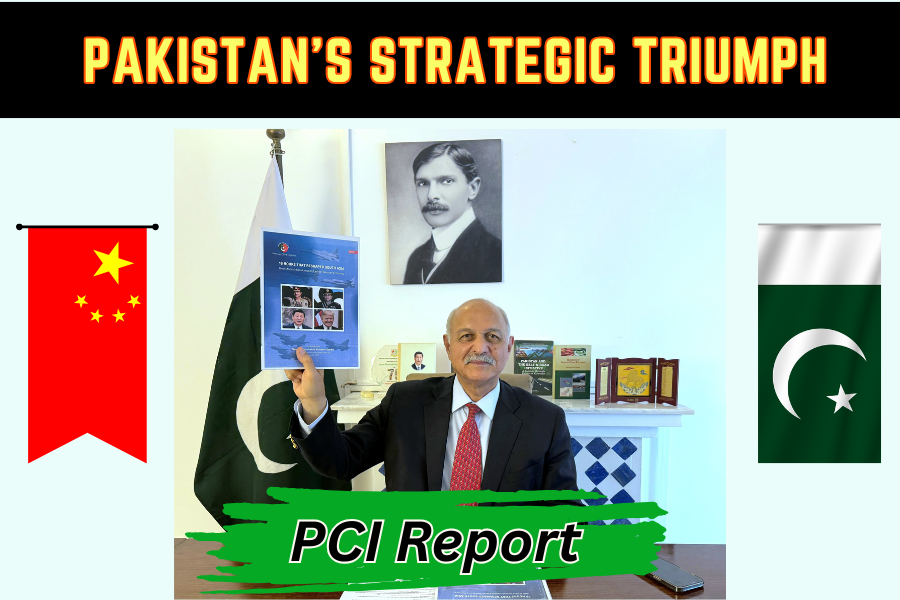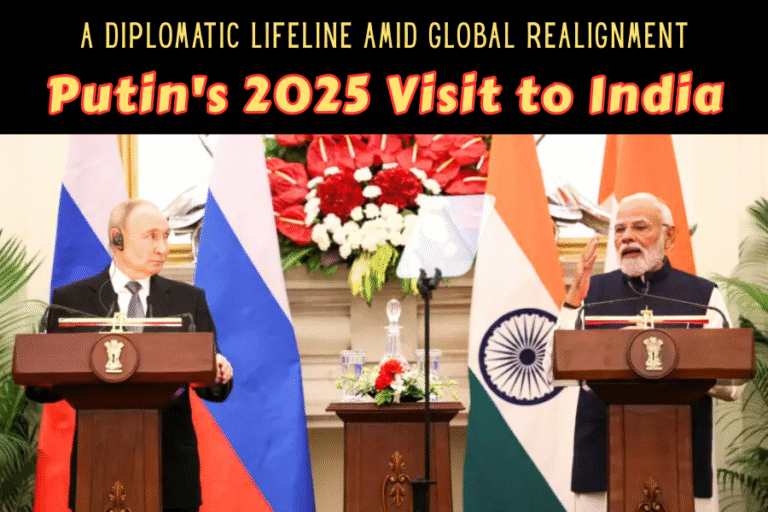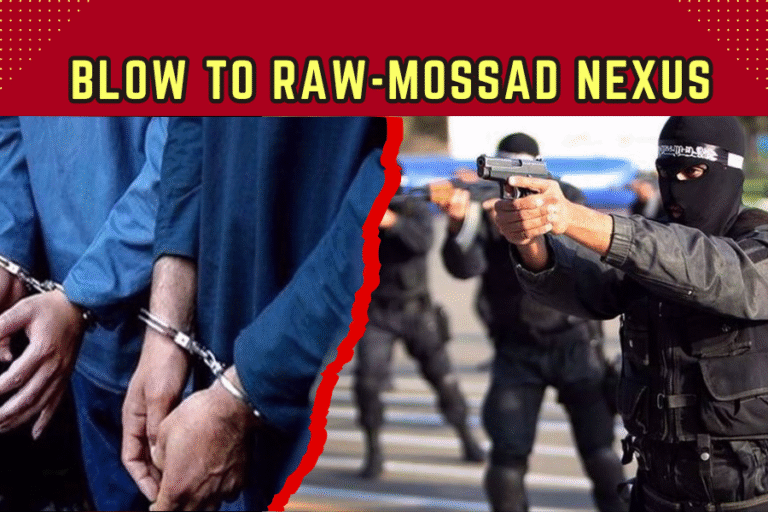(By Khalid Masood)
In a landmark contribution to South Asian geopolitical analysis, the Pakistan-China Institute (PCI), a premier non-governmental think tank founded by Senator Mushahid Hussain Sayed, has released a groundbreaking report titled “16 Hours that Reshaped South Asia: How Modi’s Miscalculation Led to Pakistan’s Primacy.” Launched on May 24, 2025, in Islamabad, this 25-page document is the first comprehensive study by a Pakistani think tank to dissect the May 6–7, 2025, Indo-Pak military standoff, known as Operation Sindoor, triggered by the April 22, 2025, Pahalgam terror attack. The report, available for download in English and Urdu at www.pakistan-china.com, offers a detailed timeline, strategic insights, and a bold narrative of Pakistan’s success, attributing India’s setback to Prime Minister Narendra Modi’s “monumental miscalculation.” This article summarizes the report’s key findings, integrates its strategic recommendations, and contextualizes Pakistan’s triumph against the backdrop of the India-Israel nexus and regional dynamics.
Gist of the PCI Report
The PCI report frames the 16-hour conflict as a pivotal moment that redefined South Asia’s strategic landscape, likening India’s defeat to its 1962 loss against China under Nehru. It details the sequence of events from the Pahalgam attack, which India blamed on Pakistan-backed terrorists without conclusive evidence, to India’s retaliatory strikes on nine alleged terror sites in Pakistan and Pakistan-occupied Kashmir (PoK). The report highlights Pakistan’s military response—a massive aerial dogfight involving 125 jets, drone warfare, and missile exchanges—as a testament to its strategic clarity and inter-service coordination.
Key Points
- Pakistan’s Military Success: The report praises the Pakistan Air Force (PAF) for its professionalism, citing the leadership of Field Marshal Syed Asim Munir and Air Chief Marshal Zaheer Ahmed Babar. PAF pilots, equipped with JF-17 Thunder and J-10C jets (featured on the report’s cover), demonstrated superior skills, leveraging sophisticated Chinese-supplied technology and electronic warfare to establish “cyber supremacy.” Pakistan’s downing of 25–77 Indian Harop drones, possibly with Azerbaijan’s intelligence, underscores its counter-drone capabilities.
- Modi’s Miscalculation: The report argues that Modi’s decision to launch strikes without evidence mirrored historical blunders, such as Hitler’s 1941 invasion of the Soviet Union. India’s loss of Rafale jets and failure to achieve air superiority marked its “most serious setback” since 1962, undermining its regional dominance.
- Role of Allies: China’s unwavering support, under President Xi Jinping, is described as a “solid rock” for Pakistan, with the report positioning China as a de facto party to the Kashmir dispute and a stabilizing force in South Asia. The United States, through President Trump’s ceasefire mediation, revived the Kashmir issue, treating Pakistan and India as equals, a diplomatic blow to India.
- Strategic Outcomes: The conflict restored Pakistan’s conventional and nuclear deterrence, countering India’s numerical superiority. Three new realities emerged: Pakistan’s strengthened deterrence, China’s central role in South Asia, and the U.S. as a peace broker. The report claims the “balance of terror” between nuclear neighbors prevented further Indian aggression.
- Recommendations: The PCI proposes a three-pronged strategy:
- Proactive Diplomacy: Reorient ties with South Asian nations, reinforce alliances with China, Turkey, Azerbaijan, Iran, and Saudi Arabia, and engage the Organization of Islamic Cooperation (OIC).
- Lawfare: Challenge India’s Indus Waters Treaty suspension and pursue cases against its RSS-led Hindutva policies in Western courts.
- Narrative Building: Use media, think tanks, and public diplomacy to counter India’s “3-D strategy” (demonize, damage, destabilize Pakistan).
Additional Insights
The report emphasizes Pakistan’s national unity, high morale, and media credibility, contrasting these with India’s political polarization. It warns of India’s ongoing 3-D strategy, urging vigilance and an effective counterterrorism policy to sustain Pakistan’s gains. Historical analogies (e.g., Hitler, Napoleon) underscore the dangers of miscalculation, while international reactions, including Turkey’s call for a Pahalgam investigation, bolster Pakistan’s narrative.
Contextualizing Pakistan’s Triumph
The PCI report’s narrative of Pakistan’s primacy must be viewed against the India-Israel nexus, a strategic partnership that amplified India’s capabilities during Operation Sindoor. As detailed in prior analyses, Israel supplied India with Harop loitering munitions, Skystriker drones, and Spice-2000 guidance kits, enabling precision strikes. Israel’s diplomatic support, including Ambassador Reuven Azar’s May 7, 2025, X post endorsing India’s “right to self-defense,” underscored its alignment. However, Pakistan’s counter-drone success and Chinese-supplied J-10C jets (outperforming India’s Rafales) neutralized India’s technological edge, validating the PCI’s claims of military superiority.
China’s role, as highlighted by the PCI, extends beyond Sindoor. The China-Pakistan Economic Corridor (CPEC), a $65 billion Belt and Road Initiative flagship, has deepened military ties, with Pakistan consuming 63% of China’s arms exports from 2020–2024, including HQ-9 air defenses and PL-15 missiles. The report’s assertion of China as a Kashmir stakeholder aligns with Beijing’s historical support, such as blocking UN sanctions against Pakistani militants like Masood Azhar. This “all-weather” partnership, likened to “China’s Israel” by General Xiong Guangkai, counters the India-Israel axis, reinforcing Pakistan’s strategic depth.
Countering India’s Regional Ambitions
The PCI report’s call to counter India’s 3-D strategy aligns with Pakistan’s broader efforts to expose India’s Israel ties and isolate it diplomatically, as discussed previously. India’s balancing act with Arab states—maintaining $184 billion in Gulf trade while importing $4.2 billion in Israeli arms—presents an opportunity. Pakistan can amplify India’s use of Israeli drones in Sindoor through Arab media, linking it to Israel’s Gaza tactics. Engaging the OIC and leveraging Iran’s anti-Israel stance can further pressure India, though Gulf pragmatism post-Abraham Accords limits responsiveness.
To isolate India for its “unprovoked” Sindoor strikes, Pakistan should pursue UN and ICJ complaints, as the PCI recommends, citing civilian deaths (31, per Pakistani reports) and India’s lack of evidence on Pahalgam. The report’s lawfare strategy, including challenging the Indus Waters Treaty suspension, can exploit India’s vulnerabilities, though India’s U.S. and Quad ties complicate isolation efforts. Strengthening alliances with China, Turkey, and Azerbaijan, as the PCI suggests, counters India’s regional bullying, with Turkey’s Sindoor mediation and Azerbaijan’s drone expertise proving valuable.
Critical Reflections
While the PCI report celebrates Pakistan’s “finest hour” during the 16-hour conflict of May 6–7, 2025, its narrative demands rigorous scrutiny to assess its claims and implications fully. The report’s bold assertions of Pakistan’s strategic triumph and India’s defeat require careful evaluation against domestic, regional, and global contexts, as well as Pakistan’s internal challenges. Below, we delve into the key points of contention, expanding on the report’s limitations and potential oversights.
- The PCI report’s claim that Indian Prime Minister Narendra Modi’s decision to launch Operation Sindoor was a “monumental miscalculation” comparable to historical blunders like Hitler’s 1941 invasion of the Soviet Union overlooks the complex domestic political dynamics in India. Despite serious military setbacks, Modi’s strikes bolstered his nationalist credentials at home. According to a Times of India poll conducted post-Sindoor, 62% of respondents viewed the operation as a decisive response to the Pahalgam attack, which killed 26 civilians in Pakistan and Azad Kashmir.
- The PCI’s dismissal of war risks, with Senator Mushahid Hussain asserting “no possibility of war,” underestimates India’s capacity and intent to retaliate, particularly given its articulated 3-D strategy (demonize, damage, destabilize Pakistan). Moreover, India’s suspension of the Indus Waters Treaty signals economic coercion, potentially reducing Pakistan’s water supply by 15–20% annually.
- The PCI’s confidence in restored deterrence—both nuclear and conventional—overlooks India’s ability to escalate asymmetrically, such as through covert operations in Balochistan or cyberattacks, as seen in past tensions. Recent attack on APS school bus at Khuzdar, Balochistan in example of such nefarious tactics.
By downplaying these risks, the report may foster complacency, leaving Pakistan vulnerable to India’s evolving 3-D tactics. - The report’s portrayal of China as a de facto party to the Kashmir dispute, while reflecting Beijing’s support during Sindoor, carries significant diplomatic risks that the PCI does not fully explore. China’s condemnation of the Pahalgam attack and its provision of J-10C jets and PL-15 missiles solidified its role as Pakistan’s “solid rock.” However, positioning China as a Kashmir stakeholder could strain Pakistan’s relations with other key allies, particularly Saudi Arabia and the United Arab Emirates, which mediated the Sindoor ceasefire alongside the US. Saudi Arabia, with $21 billion invested in Pakistan’s energy sector, has maintained neutrality on Kashmir to preserve $100 billion in trade with India. Iran, another potential ally, may also view China’s prominence skeptically, given its own strategic interests in Chabahar, where India’s influence wanes. The PCI’s narrative, while bolstering the China-Pakistan axis, overlooks these trade-offs, potentially complicating Pakistan’s multipolar diplomacy
- The PCI report’s emphasis on national unity, high morale, and media credibility during Sindoor is compelling, painting a picture of a resurgent Pakistan. However, it glosses over the country’s profound economic challenges, which threaten its ability to sustain strategic gains. Pakistan’s external debt to China stands at $26.6 billion, with $2 billion in annual repayments straining reserves. The poverty rate, at 37.2% affects 88 million people, limiting domestic support for prolonged military engagements. These vulnerabilities undermine Pakistan’s deterrence, as military modernization competes with social welfare needs. Without reforms, Pakistan risks becoming over-reliant on China limiting its strategic autonomy.
- The PCI’s recommendations for proactive diplomacy and lawfare—such as challenging India’s Indus Waters Treaty suspension and pursuing cases against its RSS-led Hindutva policies in Western courts—are pragmatic but hinge on a critical weakness: the lack of verifiable evidence to counter India’s narrative of Pakistan’s complicity in the Pahalgam attack. India’s claim linked the attack to Lashkar-e-Taiba, citing intercepted communications, though no public evidence was released by May 26, 2025. Pakistan’s denial, supported by Turkey’s call for an investigation, gains traction only if substantiated. The PCI report’s timeline of events, while detailed, does not provide counter-evidence, relying instead on India’s “lack of proof” as a rhetorical point. This gap weakens Pakistan’s ability to rally OIC or UN support, as seen in past failures to internationalize Kashmir post-2019. The report’s narrative-building strategy, using media and think tanks, is promising but requires investment in intelligence to disprove India’s claims. Without this, Pakistan’s lawfare risks being dismissed as posturing, undermining the PCI’s vision of isolating India.
Conclusion
The Pakistan-China Institute’s report, “16 Hours that Reshaped South Asia,” offers a bold and comprehensive analysis of Pakistan’s strategic triumph in the May 2025 Indo-Pak conflict. By detailing Modi’s miscalculation, Pakistan’s military prowess, and China’s pivotal role, the think tank underscores new strategic realities: restored deterrence, China’s South Asian influence, and U.S. mediation. Its three-pronged strategy—diplomacy, lawfare, and narrative building—provides a roadmap to counter India’s Israel-backed aggression and regional ambitions. However, Pakistan must address economic constraints and substantiate its claims to sustain this primacy. The report is a must-read for understanding South Asia’s evolving geopolitics, affirming Pakistan’s resilience and the enduring Pakistan-China axis.
_________________________________________________
Note: The information presented in this article is based on the PCI report and available public sources. For a comprehensive understanding, readers are encouraged to consult the original report available at www.pakistan-china.com







